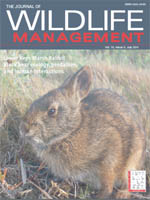Studying migratory behavior of bats is challenging. Thus, most information regarding their migratory behavior is anecdotal. Recently, however, fatalities of migratory bats at some wind energy facilities across North America have provided the opportunity and impetus to study bat migration at fine spatial and temporal scales. Using acoustic monitoring and carcass searches, we examined temporal and spatial variation in activity levels and fatality rates of bats at a wind energy facility in southern Alberta, Canada. Our goals were to better understand the influence of weather variables and turbine location on the activity and fatality of hoary bats (Lasiurus cinereus) and silver-haired bats (Lasionycteris noctivagans), and to use that understanding to predict variation in fatality rates at wind energy facilities and recommend measures to reduce fatalities. Overall activity of migratory bats and of silver-haired bats increased in low wind speeds and warm ambient temperatures, and was reduced when the wind was from the North or Northeast, whereas hoary bat activity increased with falling barometric pressure. Fatalities of migratory bats in general increased with increased activity of migratory bats, increased moon illumination, and falling barometric pressure and were influenced by the interaction between barometric pressure change and activity. Fatalities of silver-haired bats increased with increased activity, moon illumination, and winds from the south-east. Hoary bat fatalities increased with falling barometric pressure. Our results indicate that both the activity and fatality of migratory bats are affected by weather variables, but that species differ in their responses to environmental conditions. Spatially, fatalities were not influenced by the position of turbines within a turbine row, but were influenced by the location of turbines within the facility. Our findings have implications for our understanding of bat migration and efforts to reduce fatalities at wind energy facilities. To maximize the reduction of bat fatalities, operators of wind energy facilities could incorporate migratory bats' response to environmental variables, such as barometric pressure and fraction of moon illuminated, into their existing mitigation strategies.
How to translate text using browser tools
1 June 2011
Patterns of Activity and Fatality of Migratory Bats at a Wind Energy Facility in Alberta, Canada
Erin F. Baerwald,
Robert M. R. Barclay
ACCESS THE FULL ARTICLE
It is not available for individual sale.
This article is only available to subscribers.
It is not available for individual sale.
It is not available for individual sale.

Journal of Wildlife Management
Vol. 75 • No. 5
July 2011
Vol. 75 • No. 5
July 2011
Hoary Bat
Lasionycteris noctivagans
Lasiurus cinereus
migration
Silver-haired Bat
turbine-related fatalities
weather




